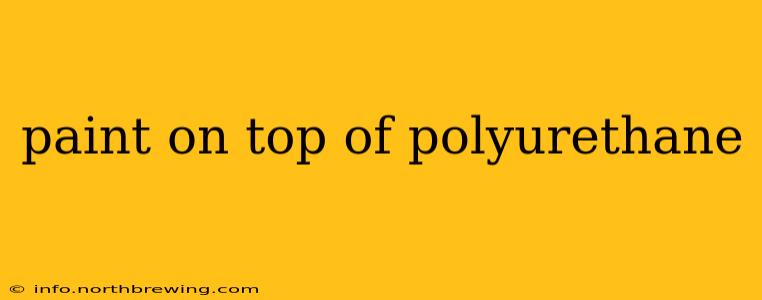Polyurethane is a durable, protective finish popular for furniture, floors, and other surfaces. However, situations arise where you need to paint over it. This comprehensive guide will explore the challenges, preparation steps, and best practices for successfully painting over polyurethane. We'll address common questions and concerns to ensure a smooth, long-lasting finish.
Can You Paint Over Polyurethane?
Yes, you can paint over polyurethane, but it requires proper preparation. Polyurethane's smooth, non-porous surface prevents paint from adhering properly without the necessary steps. Failing to prepare the surface will lead to peeling, chipping, and an overall unsatisfactory finish.
How to Prepare Polyurethane for Painting
Proper preparation is paramount to a successful paint job over polyurethane. This involves several crucial steps:
1. Cleaning the Surface
Begin by thoroughly cleaning the polyurethane surface. Use a degreaser or TSP (trisodium phosphate) to remove any dirt, grease, or grime. This ensures optimal paint adhesion. Rinse thoroughly with clean water and allow the surface to dry completely.
2. Sanding the Polyurethane
Sanding is essential to create a surface texture that allows the paint to grip. Use fine-grit sandpaper (180-220 grit) and sand in the direction of the wood grain. Don't sand too aggressively, as you want to roughen the surface slightly, not remove the polyurethane entirely. After sanding, wipe down the surface again with a tack cloth to remove dust particles.
3. Priming the Surface
Priming is crucial when painting over polyurethane. A high-quality primer specifically designed for adhesion to slick surfaces is essential. This primer will help the paint adhere better and prevent it from peeling. Allow the primer to dry completely according to the manufacturer's instructions. A second coat of primer might be beneficial for extra adhesion, especially on dark-colored polyurethane.
What Kind of Paint Should I Use Over Polyurethane?
The type of paint you choose depends on the surface and the desired finish. However, oil-based paints generally offer better adhesion and durability on polyurethane than water-based paints. Consider using a high-quality acrylic-alkyd paint for excellent durability and a smooth finish.
What is the Best Primer for Polyurethane?
A bonding primer is generally recommended for painting over polyurethane. These primers are designed to adhere to slick surfaces and provide a strong base for your topcoat. Look for primers specifically formulated for use on glossy or high-gloss surfaces.
How Long Should I Wait Before Painting Over Polyurethane?
Allow ample drying time between each step. The cleaning solution, sanding, and primer all need to dry thoroughly before applying the paint. Refer to the specific drying times indicated on the product labels for accurate guidance. Rushing the process will likely compromise the final result.
Does the Type of Polyurethane Matter?
While the specific type of polyurethane may not drastically alter the preparation process, it's important to note the finish. A high-gloss polyurethane will require more aggressive sanding than a satin or matte finish. Always test a small, inconspicuous area before proceeding with the entire surface.
Conclusion
Painting over polyurethane is achievable with careful preparation and the right materials. Following these steps diligently will ensure a professional-looking, long-lasting finish. Remember to always test a small area first to check for compatibility and to ensure you achieve your desired results. Patience and meticulous attention to detail are key to success.
